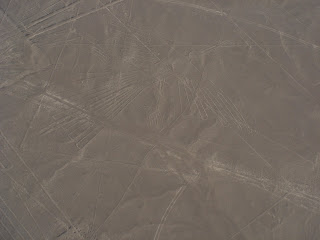The Mystery and Artistry of the Nazca Lines


Above are two pictures of the pretty incredible site of the Nazca lines. After seeing so much green in Peru, it was a bit of a shock to the system to see the desert and these dry, sandy mountains and craters. The Nazca lines are a must-see for any traveller to Peru, a highlight in a country that already has so many great things to see. I might be looking a bit ill in these pictures...because I was ill! I have been nursing a throat infection and was quite under the weather when we went on our Nazca flight, but during the time we were in the air, I could actually forget how miserable I was feeling due to the amazing views from the sky. Now almost finished with a round of antibiotics, I'm feeling much better and we head north to Trujillo tonight. Trujillo is near the site of the biggest pre-columbian city, Chan Chan.
Here we are getting into the tiny Cessna that held 6 of us (including the pilot). I've never been in a plane that small and most helicopters are bigger. But the flight was surprisingly smooth, only, in order to see the lines the pilot take very sharp turns which, in turn, turn the stomach!



This triangle was cut into the sand by the Nazca people. Was it an alien landing platform like some wacky scientists have conjectured? Or was it part of a ritual worshipping water (which seems more realistic since this is the desert after all). What makes the lines so mysterious is that no one really knows why the Nazca people created these lines, the geometrical shapes and the animal figures. Nevertheless, because of the arid climate here, the lines have remained deeply ingrained into the sand for thousands of years (they date back to between 200 BC and 700 AD).

I haven't photoshopped any of these images, so I do hope you can see the lines on your screens. Also, though it might not be apparent from these pictures, these figures are large, most spanning 100-200 meters and some sites are even the size of 3 football fields. This is a picture of a tree and two hands to its right. As you can see, the lines run continously and have no breaks in it. Some conjecture that the Nazca people walked these lines and traced the images with their footsteps in some kind of ritual. The reason this theory is backed up is that the images are often interesected with seemingly random lines that lead to areas where ceremonies took place (there's a lot of pottery remains and other religiously tied objects found on sites close to the images).

These are the hands up close. Notice that there are only 9 fingers? Also notice the road running on top of the image? That's part of the Pan-American highway which runs across the lines, but fortunately didn't destory any specific images.

A stylised hummingbird:

The mighty, mighty condor (which some say is another Peruvian bird since the beak is too long):

These are both images of the same spider...one up close and the other further away. See the line that intersect it?


The dog, upside down. Sorry about that...I forgot to reverse it before I placed it on the blog!

I think my favourite figure of all was this monkey, though unfortunately this photo doesn't do it justice. This monkey proves that the Nazca people, living in an area that doesn't have monkeys, had contact with people and animals of the jungle.

This man is called the spaceman, though most people now agree he just represents a wise man whose arms point up and down. There is a lot of disagreement about whether the lines are meant to indicate water sources or astronomical sites, but perhaps the answer lies in the spaceman who points to both the heavens and the earth.

Most interestingly, the lines weren't "discovered" until about 1939, when a pilot reported spotting figures in the sand from the sky. The biggest mystery, perhaps, is why the Nazca people would create images such as these, that could only be viewed from the sky, when there wasn't any forseeable way that they could fly themselves? Or could they...

0 Comments:
Post a Comment
<< Home